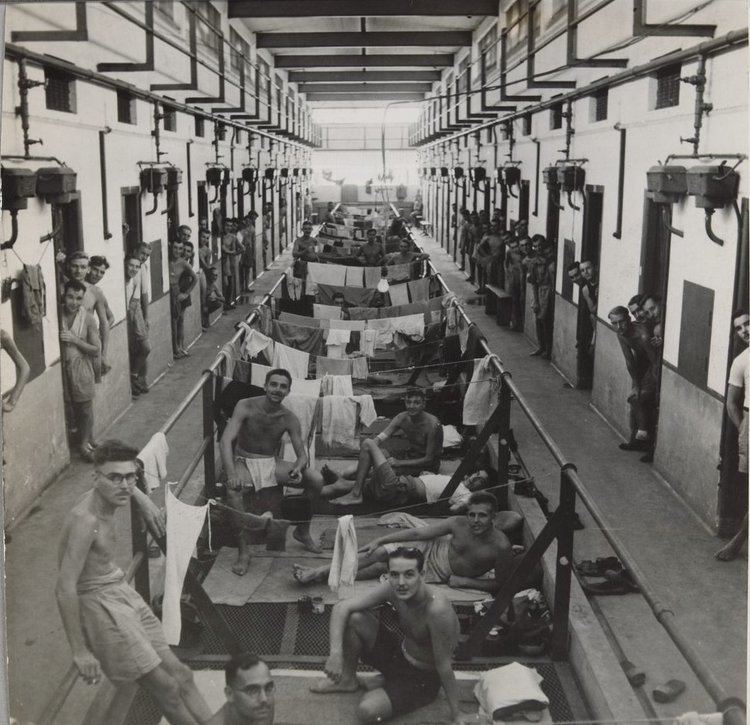Phone +65 6546 6739 | ||
 | ||
Similar Changi Prison, Changi Women's Prison, The Changi Museum, Bedok North NPC, Tanah Merah Ferry Ter | ||
Changi prison singapore singapore
Changi Prison Complex (Chinese: 樟宜监狱; Malay: Penjara Changi; Tamil: சாங்கி சிறைச்சாலை), often simply known as Changi Prison, is a prison located in Changi in the eastern part of Singapore.
Contents
- Changi prison singapore singapore
- First prison and POW camp
- Kempeitai
- Changi Chapel and Museum
- Current Prison
- Prisoners of war
- Convicted criminals incarcerated after conversion from a wartime prisoner camp
- Others
- Changi in popular culture
- References
First prison and POW camp
Changi Prison was constructed by the British administration of the Straits Settlements as a civilian prison, in 1936.
During World War II, following the Fall of Singapore in February 1942, the Japanese military detained about 3,000 civilians in Changi Prison, which was built to house only 600 prisoners. The Japanese used the British Army's Selarang Barracks, near the prison, as a prisoner of war camp, holding some 50,000 Allied soldiers, predominantly British and Australian; and from 1943, Dutch civilians brought over by the Japanese from the islands in the Dutch East Indies (now Indonesia). POWs were in fact rarely, if ever, held in the civilian prison. Nevertheless, in the UK, Australia, The Netherlands and elsewhere, the name "Changi" became synonymous with the infamous POW camp nearby.
About 850 POWs died during their internment in Changi during the Japanese occupation of Singapore, a relatively low rate compared to the overall death rate of 27% for POWs in Japanese camps. However, many more prisoners died after being transferred from Changi to various labour camps outside Singapore, including the Burma Railway and the Sandakan airfield.
Allied POWs, mainly Australians, built a chapel at the prison in 1944 using simple tools and found materials. Stanley Warren of the 15th Regiment, Royal Regiment of Artillery painted a series of murals at the chapel. Another British POW, Sgt. Harry Stodgen built a Christian cross out of a used artillery shell. After the war, the chapel was dismantled and shipped to Australia, while the cross was sent to the UK. The chapel was reconstructed in 1988, and is now located at the Royal Military College, Duntroon, Canberra.
After the war, the prison was used to hold former Japanese staff officers, Kempeitai, police, and guards from concentration camps. Executions were conducted in the inner yard where three gallows were erected. British soldiers were stationed there as prison guards. On 17 October 1945, all 260 German seamen of the former U-Boats were moved from Pasir Panjang to the prison. On 26 June 1946, all German soldiers and civilians were notified they would be shipped back to England on a passenger liner, the Empress of Australia.
Kempeitai
The prison also contained the headquarters of the Kempeitai, the Japanese military police. The Kempeitai tortured prisoners there, who they suspected were spies.
Changi Chapel and Museum
In 1988, Singapore built a replica chapel (which was built by the POWs) and museum next to the Changi Prison. When Changi Prison was expanded in 2001, the chapel and museum were relocated to a new site 1 km away and the Changi chapel and museum were officially established 15 February 2001.
Current Prison
In 2000, the old prison was demolished and its inmates were relocated to a new consolidated prison complex in a neighbouring site. In view of its historical significance, the Preservation of Monuments Board worked with the Singapore Prison Service and the Urban Redevelopment Authority to allow the front gates of the old prison to be preserved and moved to the new prison. In 1994 Changi Women's Prison and Drug Rehabilitation Centre was opened.
Presently, the new Changi Prison houses the most serious criminal offenders in the country, including criminal offenders who are serving long sentences and those who have been sentenced to death. It serves as the detention site for death row inmates at Changi, before they are executed by hanging, traditionally on a Friday morning.
Changi Prison is also one of the main places (though not the only one) where judicial corporal punishment by caning is carried out. Caning sessions at Changi are held twice per week. A former employee of the prison has been quoted as saying: "They are flogging more and more these days. Before they were doing maybe 60 on Tuesdays and Fridays, now they're doing a hundred".
On 15 February 2016, the remaining structures of the original prison – the entrance gate, wall and turrets were designated as the country's 72nd national monument.
